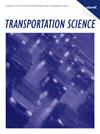Optimal Retrieval in Puzzle-Based Storage Systems Using Automated Mobile Robots
IF 4.4
2区 工程技术
Q1 OPERATIONS RESEARCH & MANAGEMENT SCIENCE
引用次数: 1
Abstract
Puzzle-based storage (PBS) systems store unit loads at very high density, without consuming space for transport aisles. In such systems, each load is stored on a moving device (conveyor module or transport vehicle), making these systems very expensive to build and maintain. This paper studies a new type of PBS system where loads are moved by a small number of autonomous mobile robots (AMRs). The AMRs (or vehicles) can travel freely underneath loads and lift a specific load and carry it to a neighboring vacant space. These systems are hard to analyze, as all the AMRs can move simultaneously with or without loads. We formulate an integer linear programming model that minimizes the retrieval time and the number of load and vehicle movements. The proposed model can handle single-load movements as well as block movements, multiple input/output points, and various constraints on simultaneous vehicle movements. The integer linear programming formulation can solve relatively small problems (a grid with up to about 50 cells) and a sufficient number of empty cells. For larger systems or those with few empty cells, a three-phase heuristic (3PH) is developed, which significantly outperforms the heuristic methods known to date and solves large instances sufficiently fast. The 3PH and an additional hybrid heuristic yield relatively small gaps from a lower bound provided by the integer linear programming model. We find that increasing the number of vehicles has a diminishing return effect on the retrieval times. Using a relatively small number of vehicles makes retrieval times only slightly longer than those obtained when having a vehicle under each load (which is equivalent to the traditional PBS systems). With single-load movement, more vehicles are needed compared with block movement to reach short retrieval times. Also, the marginal contribution of extra empty slots appears to decrease rapidly, which implies high storage densities can be obtained in practice.基于谜题的自动移动机器人存储系统的最优检索
基于谜题的存储(PBS)系统以非常高的密度存储单元负载,而不消耗运输通道的空间。在这样的系统中,每个负载都存储在一个移动的设备上(输送机模块或运输车辆),使得这些系统的建造和维护非常昂贵。本文研究了一种由少量自主移动机器人(AMRs)移动载荷的新型PBS系统。amr(或车辆)可以在负载下自由移动,并提起特定的负载并将其运送到邻近的空地。这些系统很难分析,因为所有的amr都可以在有负载或没有负载的情况下同时移动。我们制定了一个整数线性规划模型,以最小化检索时间和数量的负载和车辆的运动。所提出的模型可以处理单负载运动,也可以处理块运动,多个输入/输出点,以及同时车辆运动的各种约束。整数线性规划公式可以解决相对较小的问题(最多约50个单元格的网格)和足够数量的空单元格。对于较大的系统或空单元较少的系统,开发了三相启发式(3PH),它明显优于迄今为止已知的启发式方法,并且能够足够快地解决大型实例。3PH和一个额外的混合启发式与整数线性规划模型提供的下界产生相对较小的差距。我们发现,车辆数量的增加对检索次数有递减的回报效应。使用相对较少数量的车辆使得检索时间仅比在每个负载下使用车辆时获得的检索时间稍长(相当于传统的PBS系统)。在单载移动的情况下,需要更多的车辆来实现较短的回收时间。另外,多余空槽的边际贡献迅速减小,这意味着在实际应用中可以获得较高的存储密度。
本文章由计算机程序翻译,如有差异,请以英文原文为准。
求助全文
约1分钟内获得全文
求助全文
来源期刊

Transportation Science
工程技术-运筹学与管理科学
CiteScore
8.30
自引率
10.90%
发文量
111
审稿时长
12 months
期刊介绍:
Transportation Science, published quarterly by INFORMS, is the flagship journal of the Transportation Science and Logistics Society of INFORMS. As the foremost scientific journal in the cross-disciplinary operational research field of transportation analysis, Transportation Science publishes high-quality original contributions and surveys on phenomena associated with all modes of transportation, present and prospective, including mainly all levels of planning, design, economic, operational, and social aspects. Transportation Science focuses primarily on fundamental theories, coupled with observational and experimental studies of transportation and logistics phenomena and processes, mathematical models, advanced methodologies and novel applications in transportation and logistics systems analysis, planning and design. The journal covers a broad range of topics that include vehicular and human traffic flow theories, models and their application to traffic operations and management, strategic, tactical, and operational planning of transportation and logistics systems; performance analysis methods and system design and optimization; theories and analysis methods for network and spatial activity interaction, equilibrium and dynamics; economics of transportation system supply and evaluation; methodologies for analysis of transportation user behavior and the demand for transportation and logistics services.
Transportation Science is international in scope, with editors from nations around the globe. The editorial board reflects the diverse interdisciplinary interests of the transportation science and logistics community, with members that hold primary affiliations in engineering (civil, industrial, and aeronautical), physics, economics, applied mathematics, and business.
 求助内容:
求助内容: 应助结果提醒方式:
应助结果提醒方式:


